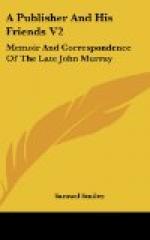The course of lectures, however, which had been designed to relieve him from the pressure of his debts, proved successful, and brought him in, it is said, as much as L1,000; whereupon he immediately set to work to squander his earnings by giving a public breakfast to his patrons, for which purpose he thought it incumbent on him, amongst other expenses, to make a new approach and a gravelled carriage road to Digamma Cottage.
Ugo Foscolo lived on credit to the end of his life, surrounded by all that was luxurious and beautiful. How he contrived it, no one knew, for his resources remained at the lowest ebb. Perhaps his friends helped him, for English Liberals of good means regarded him as a martyr in the cause of freedom, one who would never bow the knee to Baal, and who had dared the first Napoleon when his very word was law. But Foscolo’s friends without doubt became tired of his extravagance and his licentious habits, and fell away from him. Disease at last found him out; he died of dropsy at Turnham Green, near Hammersmith, in 1827, when only in the fiftieth year of his age, and was buried in Chiswick churchyard; but in June 1871 his body was exhumed and conveyed to Florence, where he was buried in Santa Croce, between the tomb of Alfieri and the monument of Dante.
Lady Caroline Lamb had continued to keep up her intimacy with Mr. Murray; and now that she was preparing a new work for the press, her correspondence increased. While he was at Wimbledon during summer, she occasionally met literary friends at his house. She had already published “Glenarvon,” the hero of which was supposed to represent Lord Byron, and was now ready with “Penruddock.” “I am in great anxiety,” she wrote to Mr. Murray, “about your not informing me what Gifford says. I think it might be a civil way of giving me my death-warrant—if ‘Penruddock’ does not.”
Whether the criticism of Mr. Gifford was too severe, or whether Mr. Murray was so much engaged in business and correspondence as to take no notice of Lady Caroline Lamb’s communication, does not appear; but she felt the neglect, and immediately followed it up with another letter as follows:
Lady Caroline Lamb to John Murray.
December 8, 1822.
MY DEAR AND MOST OBSTINATELY SILENT SIR,
From one until nine upon Tuesday I shall be at Melbourne House waiting for you; but if you wish to see the prettiest woman in England,—besides myself and William—be at Melbourne House at quarter to six, at which hour we dine; and if you will come at half-past one, or two, or three, to say you will dine and to ask me to forgive your inexorable and inhuman conduct, pray do, for I arrive at twelve in that said home and leave it at nine the ensuing morning. What can have happened to you that you will not write?
The following letter from William Lamb (afterwards Lord Melbourne), the long-suffering and generous husband of this wayward lady, refers to a novel entitled “Ada Reis.”




